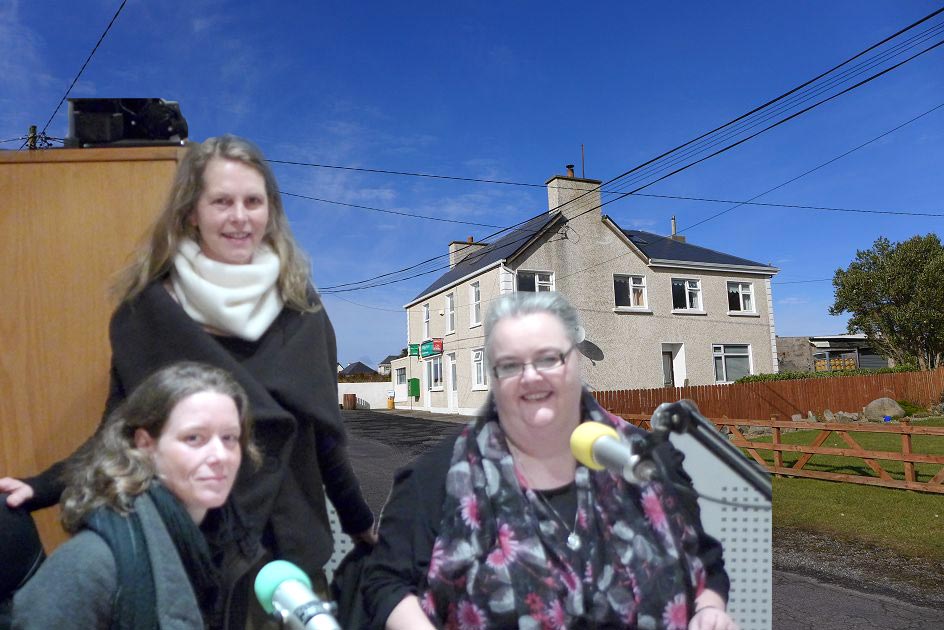
In our interview on Erris FM Edith Geraghty asked us many questions: how Doris settled in Doohoma 33 years ago (part #1), how Anja had the idea to start the “Seedbank of Love & Stories” (part #2) – and how the project has developped and became real, how it’s working and what vision we have for the “Seedbank”‘s future (part #3).
Listen to the whole interview here (29:50 min) – thanks to Erris FM for giving it to us!
or read it all here:
#1 How Doris settled in Doohoma
The space, I had loads of space
Edith: You’re listening to Erris FM broadcasting on 90.8 here at the civic centre in Belmullet. I’m Edith Geraghty and this is “Good morning Erris” and I’m delighted and excited to bring to you news of a fantastic international art project which is taking place in Doohoma post office of all places. Doris Affeldt you’re very welcomed to Erris FM.
Doris: Hey, good morning, thank you for having us.
Edith: Now Doris, tell me what brought you to Doohoma how many years ago now.
Doris: Well I arrived here in ’83. It will be 33 years this summer.
Edith: 33 years, you don’t look old enough to have lived in Doohoma for 33 years.
Doris: Thank you, but I did.
Edith: Obviously the good fresh salty sea air agrees with you. So what brought you to Doohoma?
Doris: Oh it was a mad idea, and I just said let’s try it. Because I simply loved the landscape, I loved the people and just thought this would be a good place to live. You need to be young and blue-eyed to do that, to arrive somewhere and say lets try it. And of course, there where loads of difficulties, but we persevered and I am still here.
Edith: What was the biggest difference you would have noticed at the beginning?
Doris: The space, I had loads of space
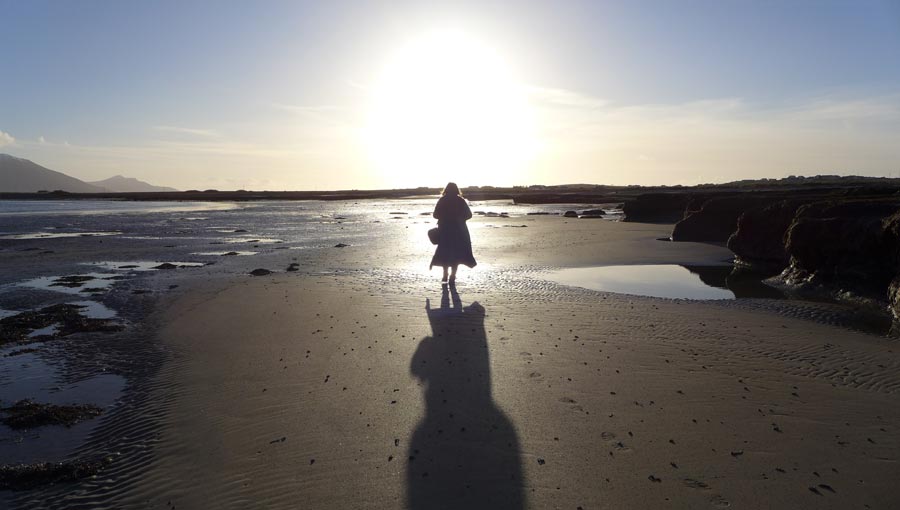
Edith: Yeah, we do have a horizon
Doris: Yes, yes, and to be by the sea is doing something really nice to me, I love that. It’s the land, the people and the sea. The people are a big factor, like the really warm welcome I got in Doohoma.
Edith: yes there’re wonderful people. I think the people of Erris in general, I think you know we’re almost like an island here, … and the thinking is different here, you know the people are different here, they’re lovely, they’re warm and they’re so self-reliant because they have always been so far away from everything else, but actually extremely progressive as well. It’s the best combination I’ve ever found for a foreign area. So 33 years in Doohoma, you must have seen Erris change over that time.
Doris: yes, in a sad way because there are a good few people from the village who really made the village what it was and I think of John Cafferkey or Eamon Heston people like that and they are gone and it’s sad. It’s a lesser place
Edith: yes, an d small villages are so based upon the characters of the people who live there. They really create the identity of the area and it’s a huge loss when they’re passed away because their history passes with them, their personality, who they were, all the people they spoke to, the people they knew.
Doris: They have not been replaced. They left a big gap.
Edith: Absolutely.
Doris: Also, when I came here, there was only one car in the village. No-one in the village had a tractor. We had to get Michael Doocey from the next village for any harvest. ‘Meitheal’ was still in full swing, which made it very easy for us to arrive, because we just worked alongside everyone.
Edith: You were helping people bring home their turf; they were helping you bring home yours.
Doris: It didn’t take any time, any warm up time. It was from day one and so we were lucky in that way, to integrate like that and of course you meet. And it’s a different way of meeting when you work together.
Edith: When you’re working side by side. Bulk bonding.
Doris: Under the Midgies.
Edith: Absolutely.
Doris: And so that was a really precious time. Even thou it was not an easy time, but it was really good.
Edith: A good time.
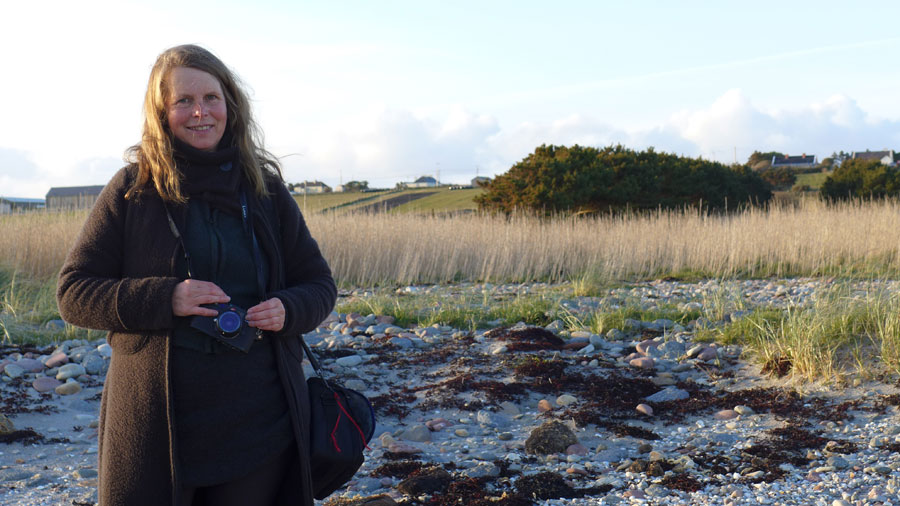
Doris: Yeah. So that’s a big change to now. Everyone has a car. Now we don’t have to meet on the road anymore.
Edith: Some of the older residents of my village would say to me that in days gone by we would have to do everything by hand, do every single piece of work from dawn till dusk, but we always had the time to stop and talk to each other. Now they have every labour saving device known to mankind and beyond and nobody has the time to talk to each other.
Doris: What happened there?
Edith: And so what have we lost in transition? Our gadgets have made us too independent. So I think so in some ways. We don’t need the human presence as much.
Doris: Looks like it.
Edith: But we can get this back and projects like this are going to do that. You’re listening to the voice of one of my guest this morning, Doris Affeldt and we will be back with this extraordinary story after some music
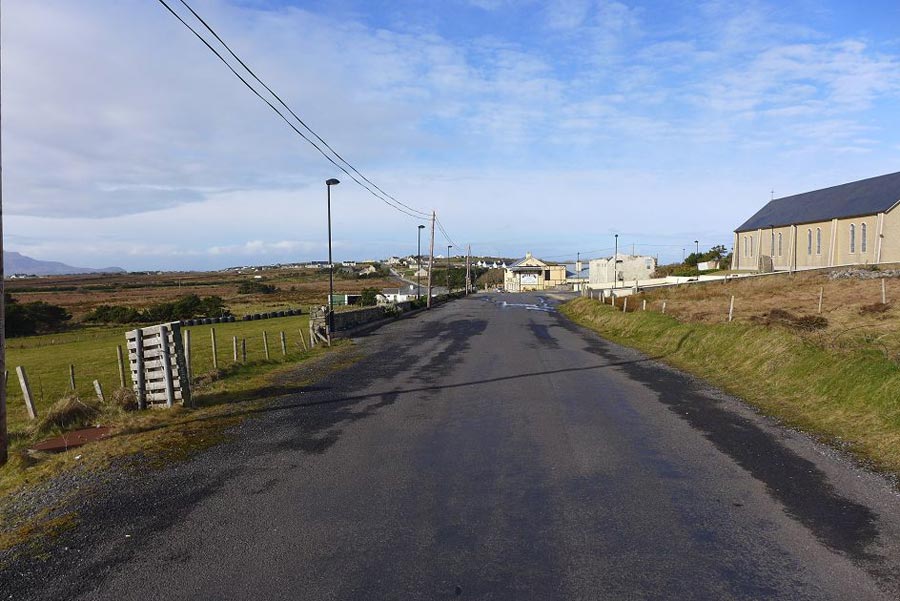
#2 – How cabbage brought Anja to Doohoma
During my pomegranate tree project I understood that it was working with people and so people came into my projects and it widened it up for me
Edith: I’m back you’re listening to Erris FM broadcasting on 19.8. Now we’re talking to Doris Affeldt this morning and we also have the artist, Anja Uhlig with us in studio. Now Doris talk to us about ok You’re in Doohoma. You know times are changing, the village is changing, but you’re going back to the old ways really, aren’t you?
Doris: You can’t go back to the old ways, but try to use the good bits of it. So what I loved about the old ways was that we worked together and so now we started this project with Anja. She asked me some years ago already if I would collaborate with her and that’s a nice word, I love that.
Edith: And how did you know Anja?
Doris: We met some seven years ago at a seminar in Italy. We were housed together in a room. So it was potluck. We ended up spending three weeks in a hotel room, so sharing a hotel room and we became good friends and so eventually I invited her and it took, I think it took somebody to come from abroad to see what we have, with a sense of something and really see what is there and spark an idea.
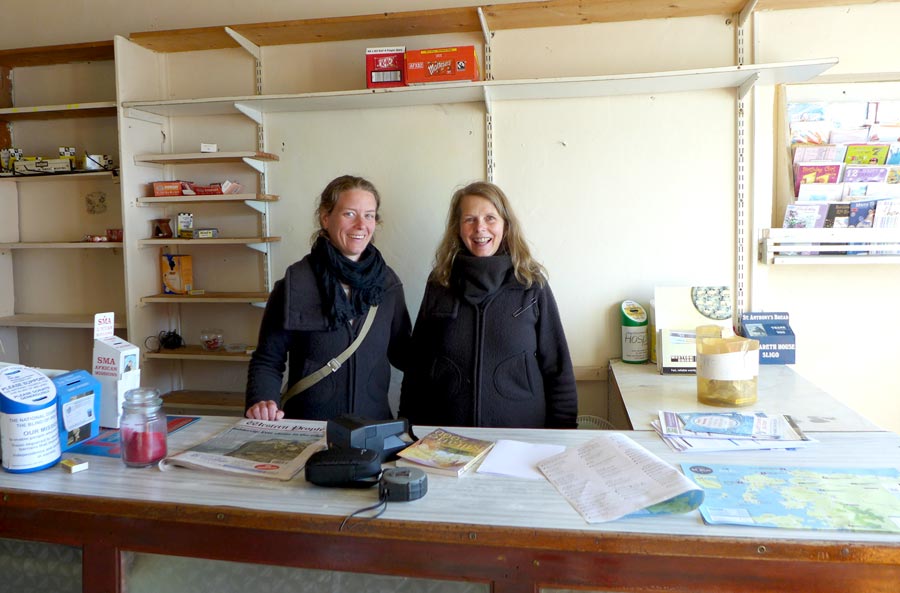
Edith: Now Anja, you’re very welcome to Erris FM. Tell us about yourself as an artist. Tell us what you’re specialized in and what brought you to this line of work.
Anja: Thank you for being here. I was working as an artist. At first I tried to draw to make videos and so and then I found it’s a quite lonely work and I didn’t feel so happy. Everbody want to show his work and in the end you stand there alone and so I started to do projects dealing with places and with people. At the beginning with places.
Edith: So you wanted to collaborate with others?
Anja: Yes
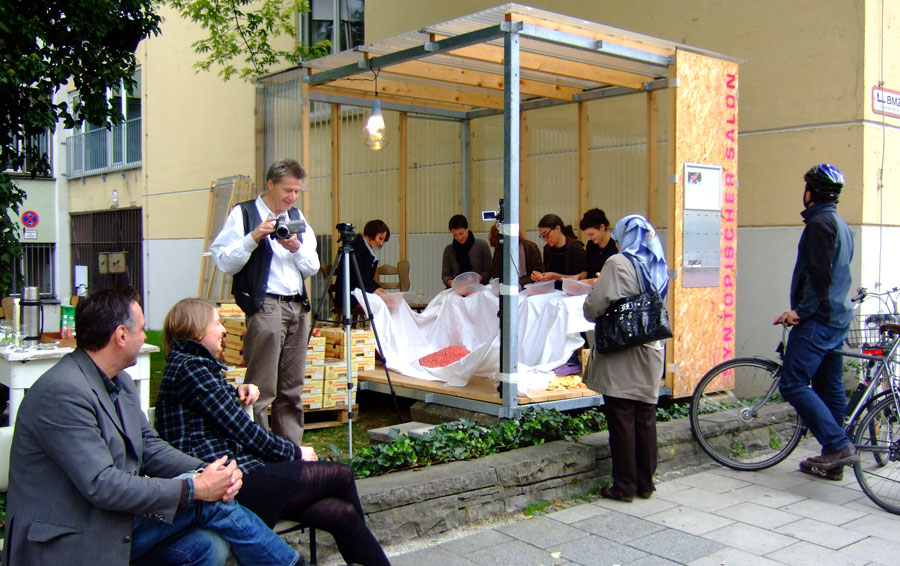
Edith: In a sense of what Doris is talking about, that kind of communal sense.
Anja: Yes, but at the beginning it was said I was working alone, but in public space and in my projects I came up to get in touch with people. One of my first projects was that I gave pomegranate trees in care to people in order to care for them and at the beginning for me this was only a pomegranate tree project and then when I saw these people, I took photos and I saw the people being so happy with their little pomegranate trees, I understood that it was working with people and so people came into my projects and it widened it up for me.
Edith: And why pomegranate trees?
Anja: Oh that’s a long story
Edith: Of all tree types in the world why that particular one?
Anja: It was because I was working on a project which was called “The Spitsbergen Project”. It was dealing with edible plants. I felt, in our world it is important to have a look at that and I was invited with an installation I did with cabbage and they invited me to an exchange project.
Edith: An installation with cabbage well you have to tell us about that now. I mean this is cabbage The Irish are very fond of cabbage.
Anja: Ah really, but that’s really a long story and I did it under the earth in Munich, in a tunnel.
Edith: In a tunnel?
Anja: It’s an art space and I wanted to try out if cabbage is growing underground because I heard of the seed bank on the Island of Spitsbergen, it’s called Svalbard, and it’s …
Edith: … an extraordinary depository of all kinds of seeds from all over the world, held in perpetuity to preserve species.
Anja: Yes and it’s preserving for even if there’s happening an atomic disaster …
Edith: We would be able to continue to feed ourselves
Anja: But I was thinking “can we really”? After that disaster? Because maybe there’s nothing and I wanted to try if they grow on the earth, they don’t. But there was the installation for some days and with that installation I have been invited to an exchange project with Istanbul in Turkey. And pomegranates came into my mind and so we peeled 613 pomegranates in Munich in public space for one day. It was a lot of work and we made jam out of them and from every pomegranate I asked people to leave one seed for me, for my project and so I have 613 pomegranate trees now and I gave them to people in Munich and Istanbul in order to care for them. And 202 are left because I had to stop the project in Istanbul. There were the riots in 2013 and I’m still standing there and these trees also brought me here to Ireland. Because Doris invited me 2 years ago to come for a visit to her and I had in mind the remaining pomegranate trees, and I thought I had to find out maybe how to continue the project and so I came here.
Edith: I see. So when you came here what did you think?
Anja: Before? Or when I was here?
Edith: Did you have any ideas before you came here of what it would be like?
Anja: I’ve been in Ireland when I was younger one time and I remembered an island which was very, very beautiful and I could not think. My brain was really out of order. It was a little bit the same when I came back here. And it’s beautiful, it’s a beautiful landscape and for me being from Munich it’s really a wide space.
Edith: Absolutely, absolutely. As I said that big horizon line, that sea that’s going on, that endless sea. Ok, you’re listening to the voice of my guest today Anja Uhlig and we’ll be back with Anja and Doris after some music.
#3 – What is The “Seedbank of Love & Stories”?
The “Seedbank of Love & Stories” is a place where stories can be swapped … . It makes the post itself visible and with the post office the people living here and the people giving stories or swapping stories here.
Edith: Yes indeed welcome back you’re listening to Erris FM broadcasting on 90.8. … Now there is an opening this evening, Friday the 11th of March between 6 and 8 p.m in Doohoma Ballina at the Doohoma post office and they are launching the “Seedbank of love & stories” and we’re privileged to have with us today the artist Anja Uhlig, and Doris Affeldt also who’s been working on the project. So tell us Anja what is the “Seedbank of Love & Stories”?
How Did the project begin ?
Anja: The “Seedbank of Love & Stories” is a place where stories can be swapped and it makes visible the space in the post office. It makes the post itself visible and with the post office the people living here and the people giving stories or swapping stories in the “Seedbank of Love & Stories”.
Edith: So when you came and visited here and walked into Doohoma post office is that when your mind started thinking when you saw the space?
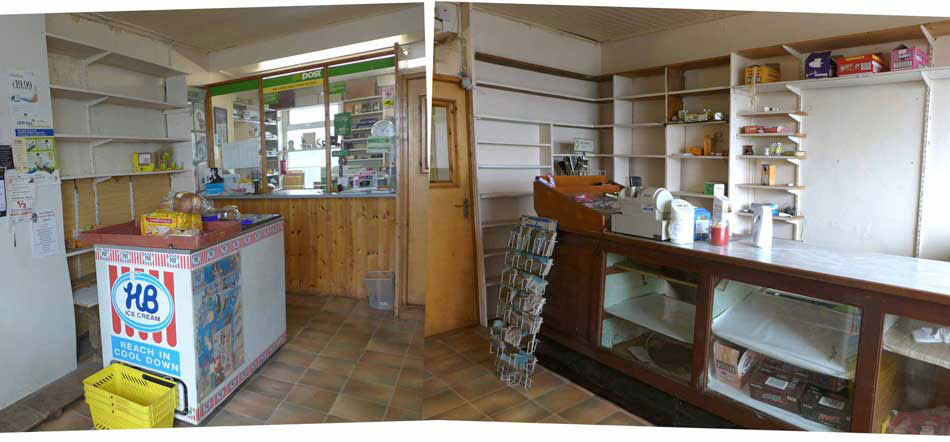
Anja: It was strange because I said before that sometimes in Ireland I cannot think, that my brain was not working. I came there occasionally because a friend asked me to send her a postcard when I was in Ireland and so we went into the post office, Doris took me with her and I came in there and for me coming from Munich it was really like another world. I saw the post office and I met Ann working there and I saw the front section of the post office which has been a shop before and I saw that it’s not working so much anymore because people now have cars and go shopping elsewhere and that was my impression and I bought one of these postcards which were there for times, I think, and I bought many for me too because I love them and so it was one of these places you feel something but you cannot, yes there are many places here, where you feel a little bit overwhelmed and it’s strange and you’re a stranger and okay, but when I came back home to Munich …. no before there happened another thing: I met an artist in Galway and she was talking to me about stories. She had a project where she swapped stories with jam. And so for me, I became aware, that in Ireland stories are very important.
Edith: Absolutely
Anja: And when I came back to Germany and it was relieved and the plane went on the ground on Munich airport maybe my brain was switched on again
Edith: Ticking again
Anja: And I thought this place would really be a swapping point for stories and because I loved the space and I wrote the concept and I asked Doris if she could imagine that something like this could happen and she said yes.
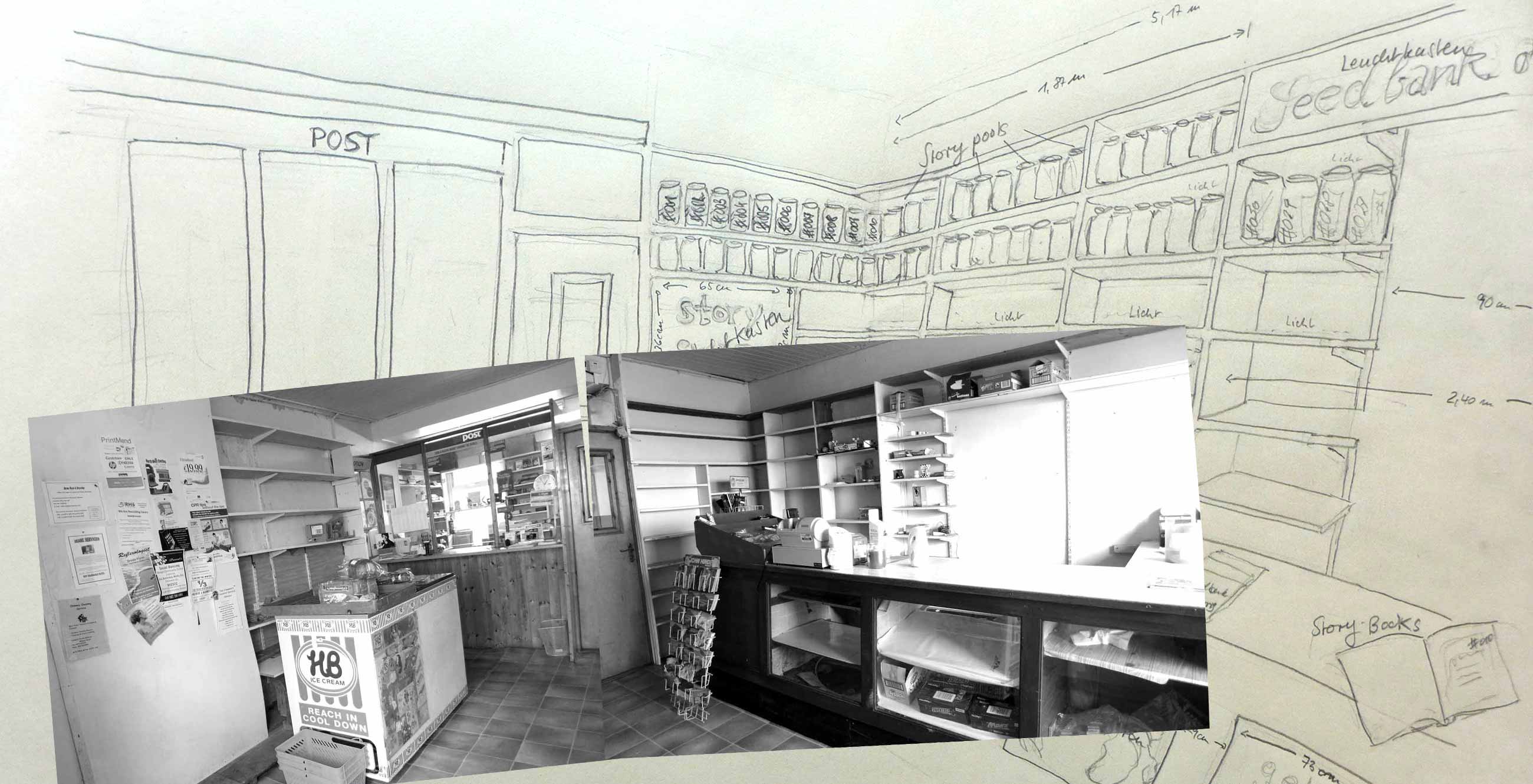
Edith: So Doris, you got this wonderful idea. Tell me what happened next.
Doris: Yes, when Anja came along with that it felt really exciting and sufficiently mad.
Edith: Always the hallmark of a good artist, sufficiently mad.
Doris: sufficiently mad and yes we talked to Ann.
Edith: Yea, Ann Heston is the owner and proprietor of Doohoma post office. A long history of the Heston family there of course in Doohoma. Many, many generations …
Doris: … and so yeah she eventually warmed to the idea and by now she’s actually excited about it. And she was a great help in putting it together
Edith: … and her son, Joseph, you thanked him especially for all his help as well.
Doris: Yea
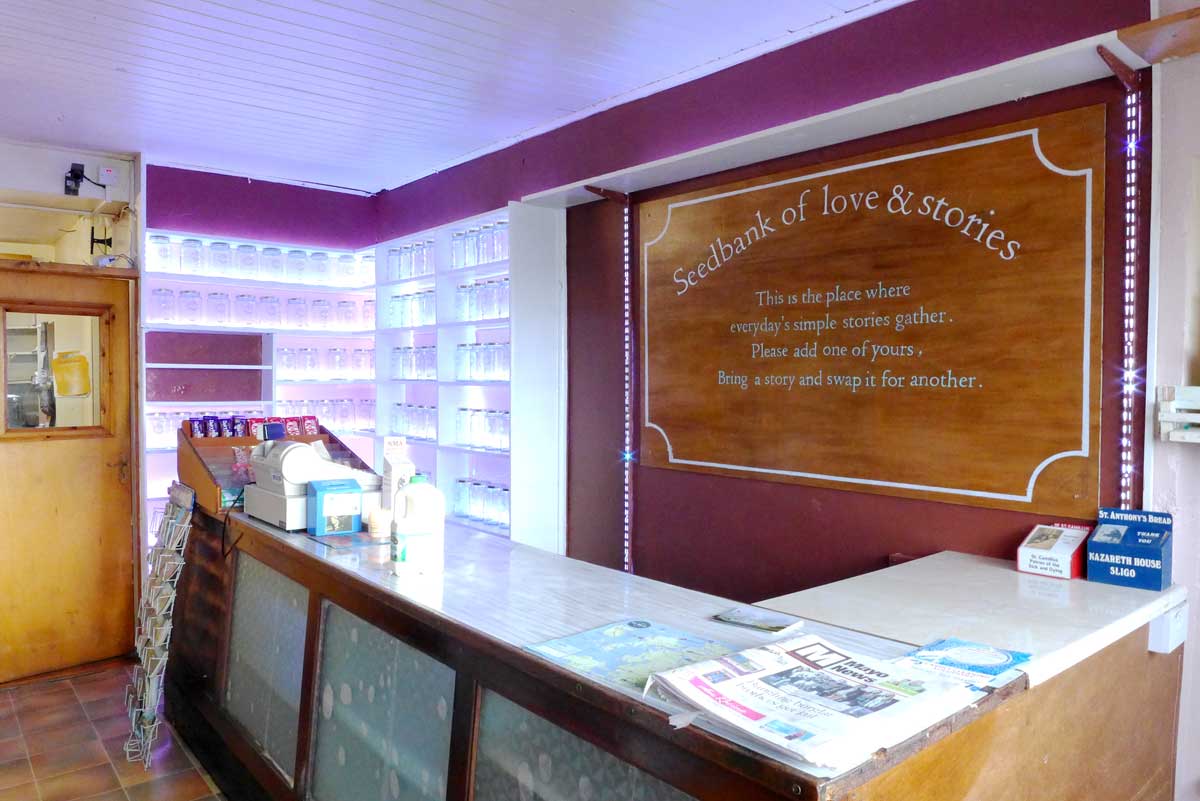
And How Does the Story swap work?
Edith: Now tell me, so how does this work? Have you got pigeon holes here on the wall, so how does this work?
Doris: Anja, do you want to answer that?
Anja: I’ll try. It’s looking a little bit strange maybe, but I love to work with the things that are already there
Edith: Okay
Anja: And so I was very happy that Ann said, that we could use the space and we were free to do what we wanted to do and there were the old shelves and we painted them in white and I tried to use them all and we painted the part behind the counter, that’s the Seedbank’s part and there are 144 glass jars there and the stories will go in there
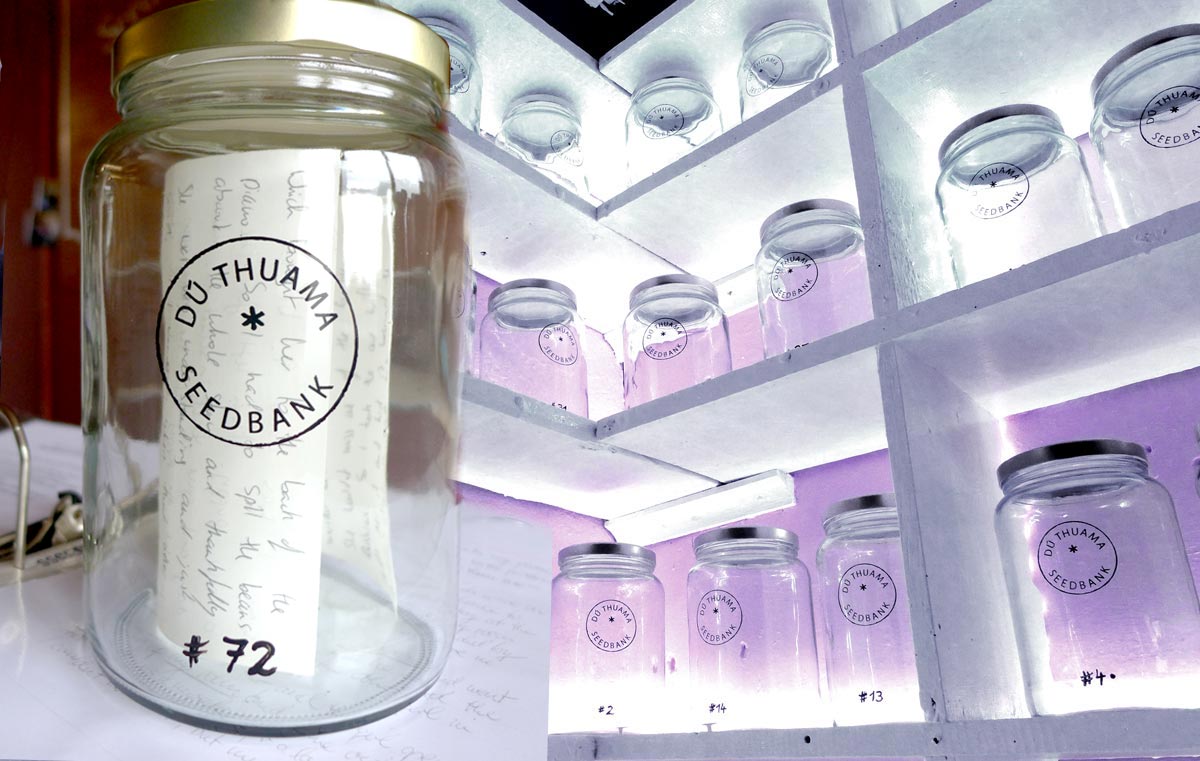
Edith: Like kilner jars or something similar
Doris: yes
Anja: And they’re numbered and they have the logo, the “Seedbank” on them, quite beautiful and when somebody comes in with his or her story you can choose a jar and put your own story inside and get the other story which nobody has read before apart from the one who put it inside
Edith: Okay, so the way this works is if I…, no when you say “a story” it could be a long story, it could be a short story, it could be a note maybe of something momentous in their lives, something that sings to them, speaks to them
Anja: It’s about the small stories, the everyday stories that happen and they’re important to you
Edith: Like you’re going to the well for the water together with your mother whilst a child or something along those lines. So you write this down, you come in, you open a jar, you check out the story that’s in that jar, you put in your own story. Now what do you do with the story that you have taken out? Do you read this?
Anja: You ask Ann to do all this … And she then also takes a photocopy of the story that’s going out, because we are having a folder where these are archived and you can read them also when you come in.
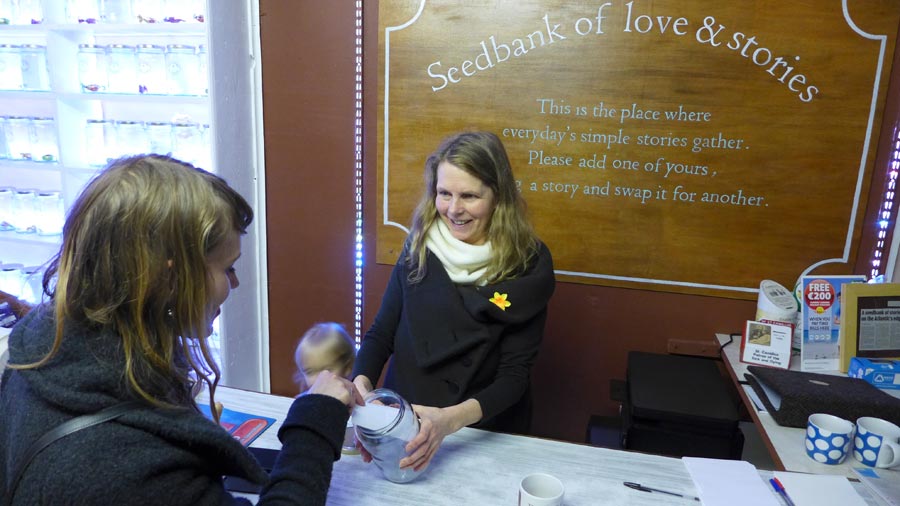
Edith: Would you take that story away with you. That’s yours to keep, that’s your part of the project as somebody will take your story away and they’ll keep that as your part of the project .
Anja: Yes. and so you can be sure that your story will be read one time.
Edith: And you’re keeping an archive so you’ll know of all the stories that are being exchanged. Sounds extraordinary and what a historical archive in years to come as well, you know, because I’m sure, lots of memories of people, lots of stories. So where did you get the original stories to start the project?
Anja: That’s a really good question. We had this question, too. Fortunately I’ve been invited in Munich for 2 presentations for the project in January and February and we collected around 25 stories there and Joseph and Ann and Doris already contributed stories for the start up and so we have around 30 stories which can be exchanged now.
Edith: For the seeds of your “Seedbank”
Anja: Yes, and for the rest because the jars were empty, we bought Easter eggs. Somebody may swap a story for an easter egg and so make the start. And the People who contributed in Munich, they will get a photocopy back because that was my promise to them. (they got a postcard in the end)
Edith: So the opening is tonight Doris?
Doris: Yes, its tonight from 6:00 to 8:00 and I was just thinking as you mentioned the Heston family. It was really close to my heart this project in that line because the post office and specifically the Heston family have always been where the stories have always gathered already, but not visible.
Edith: Yes, yes, yes, yes, yes. That’s where people meet, exchange you know all the daily greetings, all the news of the village, who’s sick, who’s unwell, who needs help, who has left here.
Doris: And it doesn’t even end there. It’s not just about the people in the village. Every house you see in the area has at least a dozen of people who live somewhere on the globe but we are connected by heart strings.
Edith: Yes, yes, yes, yes
Doris: So their news are being exchanged as well. So it’s a much bigger place than it looks
Edith: Absolutely, absolutely
Doris: And if you think about it a bit longer Doohoma post office becomes the centre of the world
Edith: Yes, yes, yes
Doris: For all these meets and it’s not visible at all. You look at it from the outside and it seems that nothing is happening here, and there’s so much going on here
Edith: There’s so much happening. There’s so much happening, absolutely. Now I know you have a lot of people you want to thank in helping you set up this project, Ann of course and her son Joseph. And I know you’re talking about Michéal Holmes for painting this sign for you.
Doris: Yes, we’ve got a beautiful sign made by him, he’s such an artist and he’s so happy and willing to do it and its a beautiful really big sign now in Doohoma post office.
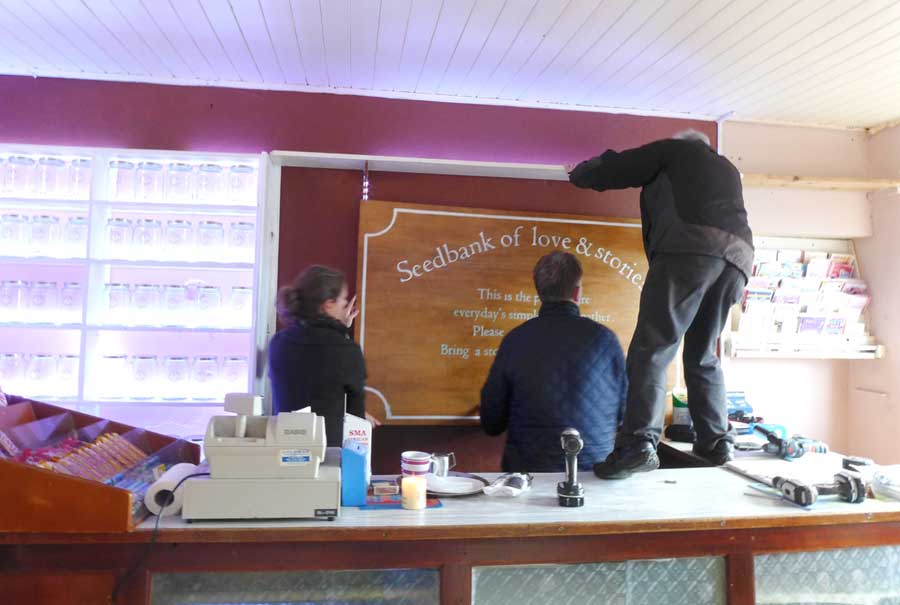
Edith: And what about Pat Chambers and Kyle who helped you with with the hands-on support?
Doris: yeh, Pat helped to hang the sign and was very happy to offer a soldering tool as well when we were stuck and even offering his daughter to play a few tunes.
Edith: Well you can’t have an opening without music …
Doris: and so one of strip lights and all these jars are beautifully lit by strip lights but one of the strips didn’t work and Kyle came in, Kyle Holmes to try and fix it and Sheamus helped to carry the big sign from the pub where it was painted …
Edith: So the fact is you want it to be a community coming back together to do something extraordinary. Now people who are going this evening, they can come prepared with a story?
Anja: Yes, they can come prepared with the story or write it then.
Edith: There will be pen and paper there for them to write something there and then or they can come tonight, have a wonderful evening and come back again with the story. Can they, is it just one story they’re allowed to contribute? Can they take several jars?
Anja: You can contribute as many stories as you like. You can also come back after one month and take another one and not too big, moderate and I think and I hope that people will come back.
Edith: And how long is the exhibition opened out to this in Doohoma?
Anja: It starts working now
Edith: It starts working from now
Anja: And then it will be opened at the post office’s opening hours
Edith: Okay
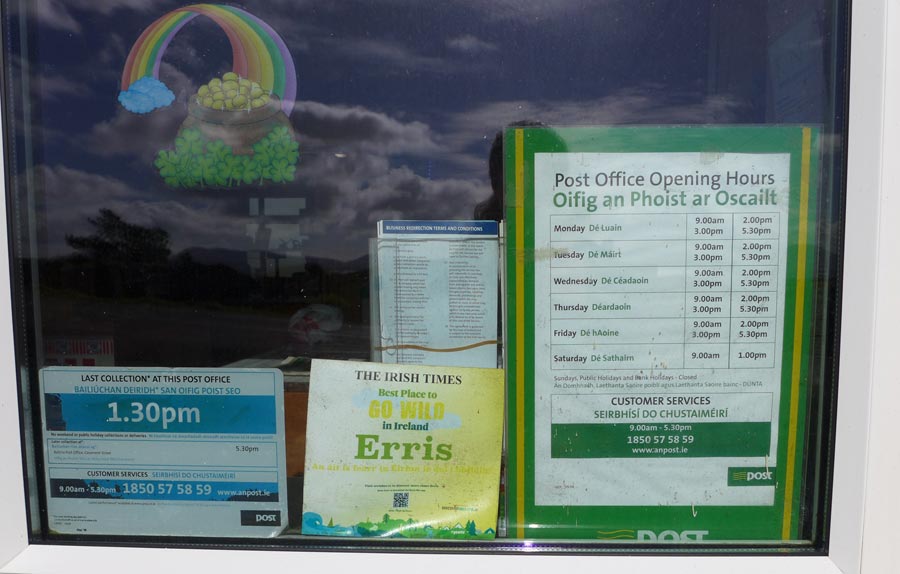
Anja: and I hope we will go on and we will travel with the project
Edith: Absolutely amazing.
Anja: So we can bring stories, which are collected here, in the world and bring other stories back. I’ve really a vision of this as a world-wide project
Edith: Absolutely, absolutely. I’m just seeing in my mind’s eye that fantastic file growing of all of these stories. You know this archive of memory and stories. … Ladies thank you very much for joining us today. Anja, thank you very much for your artistic vision which is going to enrich not only our communities, but a lot of communities around the world and it’s such an extraordinary idea, you know what I mean, I think it’s absolutely wonderful and Doohoma is blest to have you. And we look forward to the opening tonight which is at 6:00 pm in the Doohoma post office and it’s running till 8:00. There will be music, there will be crack, it’s Ireland after all and there will be plenty of stories and so. Thank you so much both of you for coming in.
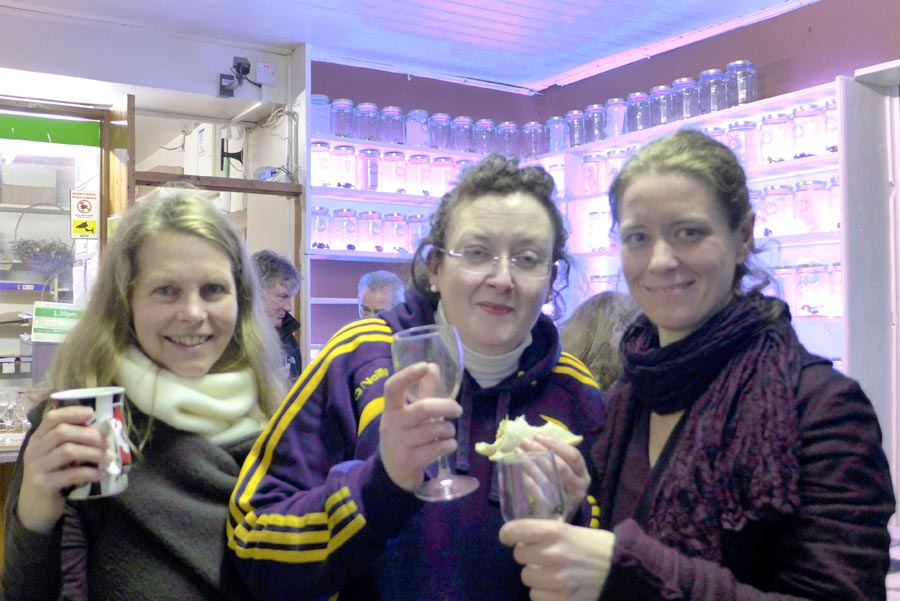
The interview took place on Erris FM 90.8 in the morning of the Seedbank’s opening day, on 11th of March 2016.



